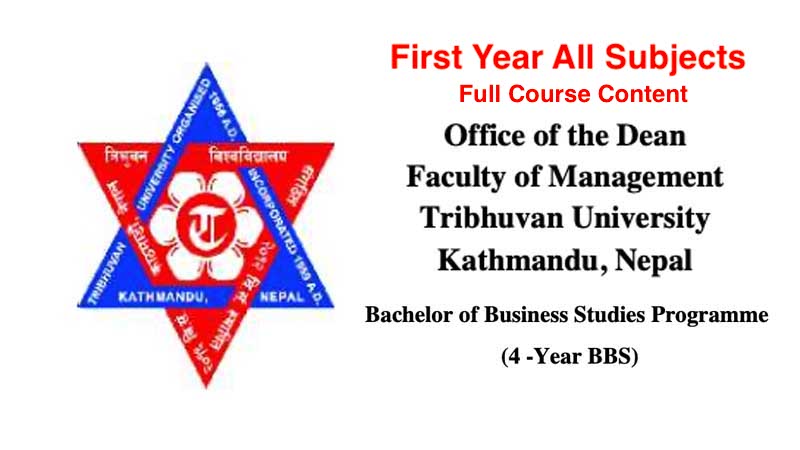TU BBS first year all subject syllabus
Bachelor of Business Studies offered by Tribhuvan University of Nepal has 5 subjects each weighing 100 marks in first year. These 5 are the compulsory subject for BBS 1st year. The subject to be studied in TU BBS 1st year are as follows along with their respective subject code.
TU BBS First year Subject Code and Subjects | ||
| Subject Code | Subject | Teaching Hour |
| MGT 201 | Business English | 150 |
| MGT 202 | Business Statistics | 150 |
| MGT 203 | Microeconomics | 150 |
| MGT 204 | Business Law | 150 |
| MGT 205 | Business communication | 150 |

Click here to view all subject of TU BBS each year.
The detail course content of all the subjects i.e. Business English, Business Statistics, Microeconomics, Business Law and Business Communication are illustrated in following tables respectively.
TU BBS 1st year Business English syllabus
Detail course content of Business English for TU BSS first year.
MGT 201: Business English Lecture Hour 150 Full mark 100 Pass mark 35 | |
| Unit 1: Interdisciplinary Approach to Learning English (15 marks) | 1) Invitation Interactions (relating to the text) and Spotlights 2) Ancient Tales Yudhisthira's Wisdom (Rao); The Brave Little Parrot (Martin); If Not Higher (Peretz);Interactions (relating to the selected texts) and Spotlights 3) Education Why go to a University? (Nissani); Don't Cut Down the Trees, Brother Woodcutter (Sama); Surely You Are Joking, Mr. Feynman (Feynman); A 1996 Commencement Speech (Rushdie); Interactions (relating to the selected texts) and Spotlights 4) Actions and Consequences The Parrot in the Cage (Paudyal); A Sound of Thunder (Bradbury); No Smoke from the Chimneys (Shrestha); Interactions (relating to the selected texts) and Spotlights 5) Television The Wretched Stone (Van Allsburg); TV Can be a Good Parent (Gore); Interactions (relating to the selected texts) and Spotlights 6) Crosscultural Bridges Marriage is a Private Affair (Achebe); Then and Now: Finding My Voice (Kim); Interactions (relating to the selected texts) and Spotlights 7) Cultural Anthropology Arranging a Marriage in India (Nanda); Life is Sweet at Kumansenu (Nicol); Interactions (relating to the selected texts) and Spotlights 8) The Human Condition The Lunatic (Devkota); How Sane Are We? (Chaudhary); Gaia (Lohani) Interactions (relating to the selected texts) and Spotlights 9) Natural Science The Making of a Scientist (Ramchandran); Scientific Inquiry: Invention and Test (Hempel); Interactions (relating to the selected texts) and Spotlights 10) Humor and Satire King John and the Abbot of Canterbury (Anon); Third Thoughts (Lucas) ; The Clock Tower (Sherchan); Interactions (relating to the selected texts) and Spotlights 11) Critical and Creative Thinking The Stub Book (de Alarcon); Mr. Know-All (Maugham); Keeping Errors at Bay (Russell); What Is Intelligence, Anyway (Asimov); Interactions (relating to the selected texts) and Spotlights 12) Love To His Coy Mistress (Marvell); The Telegram on the Table (Pradhan); Piano (Lawrence); Interactions (relating to the selected texts) and Spotlights 13) Life and Death The Great Answer (Oursler); Stopping by Woods on a Snowy Evening (Frost); A Tale (Koirala); Ethics (Pastan); "Where the Mind is without Fear' (Tagore); New Year (Parijat); Interactions (relating to the selected texts) and Spotlights |
Unit 2: Functional English Language Texts (15 marks)
| 1) Paragraph to Short Essay 2) Descriptive Essays 3) Narrative Essays 4) Opinion Essays 5) Comparison and Contrast Essays 6) Cause and Effect Essays |
| Unit 3: Reading for Writing (40 marks) | 1) Introduction to the Topic, Reading, and Discussion Reflection Discussion Preparing to read Reading for overall meaning Reading for more detail 2) Personal Written Response Journals: a private audience Shared writing Feedback on student writing 3) Further Reading, Writing, and Discussion Preparing to read Reading for overall meaning Reading for more detail Helping each other understand Discussion: Critical thinking 4) Focus on Writing Skills Using other's writing Meeting reader expectations Sentence grammar 5) Formal on Writing Skills Writing topics Generating ideas Expanding student point of view Initial drafts Review, revision, and assessment 6) Grammar and Punctuation Sentence Structure Relative Clauses Word Order Adjectives and Adverbs Punctuation |
| Unit 4: Style (15 marks) | 1) Choosing le most juste 2) Following and flouting conventions 3) Live and dead metaphors 4) Patterns of words in a text 5) Patterns of grammar in a text 6) The textual orchestration of patterns 7) The effects of the medium 8) Sequences of words and events 9) The selection of significant detail 10) Personal attitude, involvement and emotion 11) Style and ideology 12) A note on the poetic 13) Suggestions for projects |
TU BBS 1st year Business Statistics syllabus
Detail course content of Business Statistics for TU BSS first year.
MGT 202: Business Statistics Lecture Hour 150 Full mark 100 Pass mark 35 | |
| Unit 1: Introduction to Statistics | Meaning, scope and limitation of statistics, Importance of statistics in Business and Management, Types and sources of data, Methods of collection of primary and secondary data, Precautions in using; secondary data, Problems of data collection. |
| Unit 2: Classification and Presentation of Data | Data classification (need, meaning, objectives and types of classification); Construction of frequency distribution and its principles; Presentation of data: Tabular presentation; Diagrammatic presentation: Bar diagram, Pie diagram; Graphic presentation: Histogram, frequency polygon, Frequency Curve and Ogive (Illustrations related to Business and Management). |
| Unit 3: Measures of Central Tendency | Mean: Simple and Weighted (Arithmetic Mean, Geometric Mean and harmonic Mean), median, partition values, mode, Properties of averages, choice and general limitation of an average. |
| Unit 4: Measures of Dispersion | Absolute and relative measures, Range, Quartile deviation, mean deviation, standard deviation, coefficient of variation, Lorenz curve. |
| Unit 5: Skewness, Kurtosis and Moments | Meaning, objective and measurement of Skewness, Karl Pearson’s and Bowley’s Method; Five Number Summary, Box-Whisker Plot; Kurtosis and its measurement by Percentile method; Meaning of moments, Central and Raw moments and their relationship; Measurement of Skewness and Kurtosis by moment method. |
| Unit 6: Simple Correlation and Regression Analysis | Karl Pearson’s correlation coefficient including bi-variate frequency distribution, coefficient of determination, Probable Error, Spearman’s Rank Correlation coefficient; Concept of Linear and Non-linear regression; Simple linear regression equations including bi-variate frequency distribution, Properties of regression coefficients. |
| Unit 7: Analysis of Time Series | Meaning, need and components of time series. Measurement of trend: Semi-average, moving average, method of least squares; Measurement of seasonal variation: Method of simple average and Ratio to moving average |
| Unit 8: Index Numbers | Meaning and types of Index Number; General rule and problems in construction of Index Number Methods of constructing index numbers: Simple and weighted (Aggregative and Price Relative Method) Laspeyre’s and Paasche’s Index Number, Fisher’s Ideal Index Number; Time and Factor Reversal Tests Cost of living index number (Consumer’s price index number): Aggregative Expenditure Method and Family Budget Method, Base shifting and Deflating |
| Unit 9: Probability | Definition of probability, Addition and Multiplication theorem, Application of Combination in Probability, Conditional probability and Baye’s Theorem. |
| Unit 10: Sampling and Estimation | Meaning of sample and population, census versus sampling, Sampling Techniques, Concept of Sampling distribution, standard error, Estimation, estimator; Concept of types of estimates: Point and Interval |
| Unit 11: Quantitative Analysis | Introduction to quantitative analysis; Application of management science: Scientific approach to decision making, Decision making under the condition of uncertainty and risk, Expected Profit, Expected Profit with perfect information and Expected value of perfect information, Linear Programming Problem: Problem formulation with two decision variables, Graphical solution of Maximization and Minimization problems. |
| Unit 12: Determinant | Definition of determinant, Methods of finding the numerical values of determinant up to three order, Properties of determinant and its use to find the numerical values of determinants, Cramer’s Rule to solve simultaneous equations up to three variables. |
| Unit 13: Matrix | Definition and types of matrix, Addition, subtraction and multiplication of matrices, Cofactors, Transpose, Adjoint and Inverse of a matrix, Inverse and Row Operations method to solve simultaneous equations up to three unknowns. (Illustrations and applications in all chapters should be based on Business and Management situation as far as possible.) |
TU BBS 1st year Microeconomics syllabus
Detail course content of Microeconomics for TU BSS first year.
MGT 203 Microeconomics Lecture Hour 150 Full mark 100 Pass mark 35 | |
| Unit 1: Introduction (LH 5) | Concept of business (managerial) economics; Relation of business economics with traditional economics; Meaning, scope, use and limitations of microeconomics. |
| Unit 2: Theory of Demand and Supply and Equilibrium Price (LH 20) | Demand function, determinants of demand, movement and shift in demand curve; Supply function, determinants of supply, movement and shift in supply curve; Market equilibrium; Change in equilibrium due to shift in demand curve and supply curve. (Numerical exercise) |
| Unit 3: Elasticity of demand and supply (LH 20) | Concept and types of price, income and cross elasticity of demand; Measurement of price, income and cross elasticity of demand: Total outlay, point and arc method; Uses of price, income and cross elasticity; Concept of elasticity of supply; Measurement of elasticity of supply. (Numerical exercise) |
| Unit 4: Theory of Consumer Behavior (LH 20) | Concept of cardinal and ordinal utility analysis; Cardinal approach: Assumptions, consumer's equilibrium, criticisms and derivation of demand curve (cardinal approach); Ordinal approach: Indifference curve: Concept, properties, marginal rate of substitution, price line and consumer's equilibrium; Price effect: Derivation of PCC; Income effect: Derivation of ICC; Substitution effect: Hicksian approach; Decomposition of price effect into income and substitution effect: Hicksian approach; Derivation of demand curve: (ordinal approach). (Numerical exercise) |
| Unit 5: Theory of Production (LH 16) | Production function: Meaning, long run and short run production function and concept of Cobb-Douglas production function; Concept of total product, average and marginal product; Law of variable proportions; Isoquant: Meaning and properties; Marginal rate of technical substitution. Iso-cost curve. Optimal combination of inputs. Laws of return to scale. (Numerical exercise) |
| Unit 6: Cost and Revenue Curves (LH 17) | Concept of cost: Actual cost and opportunity cost, implicit cost and explicit cost, accounting and economic cost, historical cost and replacement cost, separable cost and common cost. Derivation of short run cost curves. Reason for the 'U' shape of short run average cost curve. Derivation of long run cost curves. Relationship between short run and long run AC and MC curve. Shape of the long run average cost curve: Theoretical reason and empirical evidence. Concept of economies of scale and economies of scope. Concept of revenue: Total revenue, average revenue, and marginal revenue. Revenue curves under perfect and imperfect competition. Relation between average and marginal revenue curves. Relationship between price elasticity and marginal revenue and total revenue. (Numerical exercise) |
| Unit 7: Theory of Product Pricing (LH 30) | Perfect competition: Meaning and characteristic of perfect competition; Pricing under perfect competition: Equilibrium of firm and industry in short run and long run (TR-TC approach and MC-MR approach); Derivation of short run and long run supply curve of a firm and industry Monopoly: Meaning and characteristic of monopoly; Pricing under monopoly: Equilibrium of firm in short run and long run (TR-TC approach and MC-MR approach); Price discrimination: Degree of price discrimination and price and output determination under discrimination; Dumping Monopolistic competition: Meaning and characteristics of monopolistic competition; Pricing under monopolistic competition: equilibrium of firm in short run and long run; equilibrium of firm under product variation and selling expenses Oligopoly: Meaning and characteristic of oligopoly; Pricing under cartel (aiming at joint profit maximization). (Numerical exercise) |
| Unit 8: Theory of Factor Pricing (LH 22) | Pricing of inputs in perfect competition and imperfect competition market. Rent: Modern theory of rent. Wages: Marginal productivity theory of wages, Concept of collective bargaining and minimum wages fixation. Interest: Loanable fund theory and Liquidity Preference Theory of interest. Profit: Economic and Business Profit, Dynamic Theory and Innovation Theory of Profit. (Numerical exercise) |
TU BBS 1st year Business law syllabus
Detail course content of Business law for TU BSS first year.
MGT 204 Business law Lecture Hour 150 Full mark 100 Pass mark 35 | |
| Unit 1: Introduction to Law and Business Law (LH 8) | Nature and characteristic of law, Types and sources of law, Meaning and characteristic and source of Nepalese business law |
Unit 2: General Law of Contract (LH 44)
| Meaning, Nature and definition of contract, Essential elements of valid contract. - Meaning and Rules regarding offer, Revocation/ lapse of offer, Meaning and rules regarding acceptance, communication of offer and acceptance . - Meaning of contractual capacity, Legal effects of agreements made with an incompetent party (the minor and the person of unsound mind). - Meaning and Rules regarding consideration, Exceptions to the general rule 'No consideration no contract. - Concept and importance of free consent, Meaning, and legal effects of contract caused by: Coercion, Undue influence, Misrepresentation, Fraud, Mistake. - Concept and importance of legality of objective and consideration, Conditions of unlawful agreement and void agreement. - Meaning and definition of contingent contract, Rule regarding contingent contract - Meaning and definition of quasi contract, Cases of quasi contract. - Meaning and nature of performance of contract, Responsible person for demanding contract and performance of contract, Importance of performance of contract, Rules regarding performance of contract - Meaning of termination of contract, Modes of termination of contract. - Meaning and types of breach of contract, Remedies for breach of contract. Major provision of Nepal contract. - Conceptual capacity, rules regarding minor's agreement, person of unsound mind and disqualified persons. |
Unit 3: Bailment (LH 16)
| Meaning of bailment, Rights and duties of Bailor and Bailee, Finder of lost goods (rights and duties of finder of lost goods), Meaning of pledge of pawn, Distinction between bailment and pledge, Right and duties of pawner and pawnee, pledge by non-owner. |
Unit 4: Contract of Agency (LH 12)
| Meaning and general rules of agency, Modes of creating agency, Types of agent Rights and duties of agent, Right and duties of principal, Delegation of authority, Sub-agent and substituted agent, Responsibility of agent, Personal responsibility of agent, Termination of agency, Procedure of registration and effect of non-registration of agency in Nepal. |
| Unit 5: Contract of Sale of Goods (LH 2) | Meaning and features of contract of sales of goods, Difference between sales and agreement to sell, implied condition and warranty, and caveat emptor, Transfer of ownership, transfer of title by non- owner, Rights and duties of unpaid seller. |
| Unit 6: Contract of Carriage (LH 10) | Meaning and nature of contract of carriage, Characteristics of common carrier, Difference between common and private carrier, Rights, duties and liabilities of common carrier, Carriage by land, Carriage by Sea (contract of Affreightment: charter party and bill of lading), and carriage by air, Inco terms 2010: A brief introduction. |
| Unit 7: Law of Negotiable Instruments (LH 6) | Meaning and feature of negotiable instruments, Promissory note, bills of exchange and cheque, Holder and holder in due course, Discharge of negotiable instrument. |
| Unit 8: Law of Company and Insolvency (LH 18) | Company: Meaning, Nature and incorporation of company, Insolvency: Meaning and procedure of insolvency of company, legal importance and formalities of meetings minutes and resolutions of a company, Legal provision regarding Board's report appointment of auditor, Removal of an auditor, Investigation, Re- organization and liquidation of a company, Power and role of the liquidator, Nepalese law of insolvency and feature of insolvency Act, 2003. |
| Unit 9: Arbitration (LH 12) | Meaning, features and significance of arbitration, process of appointment of arbitrators, power and function of arbitrators, disputes or cases to be settled by arbitration, who can refer disputes to arbitration, revocation of Arbitrator, authority, procedures of settlements of disputes, award, major provisions of Nepal Arbitration Act. |
| Unit 10: Indemnity and Guarantee (LH 12) | Meaning of contract of indemnity, Rights and duties of indemnifier and indemnity holder, Meaning of contract of guarantee, Types of guarantee, Difference between indemnity and guarantee, Rights, duties and liabilities of surety, Discharge of surety from liability. |
TU BBS 1st year Business Communciation syllabus
Detail course content of Business communication for TU BSS first year.
MGT 205: Business Communication Lecture Hour 150 Full mark 100 Pass mark 35 | |
| I. Business English (50%) | The course is organized around ten broad communicative units: Achievement, Motivation, Communication, The Future, Challenges, Psychology, Creativity, Image, Responsibility, and Security. Each unit begins with an agenda which gives details of the language to be studied in the unit. This is followed by four main parts: Language focus, Wordpower, Skills focus, and Focus on functions. There is a review unit after every two units. Language focus presents and practices the target grammar in a context related to the general topic of the unit. It has four stages: an introductory activity, presentation of the target grammar in a realistic context, grammar analysis, and practice. Wordpower presents and activates a lexical set or semantic field related to the topic of the unit. At the same time it introduces a variety of strategies for organizing and learning vocabulary effectively. It has two stages: introduction of topic-related vocabulary and a follow-up practice activity. Skill focus has longer listening and reading texts, which provide exposure to the target grammar of the unit and develop listening, speaking, and reading skills. It has three stages: a preview to introduce and stimulate interest in the topic, a task (s) to complete while reading or listening, and follow-up. Focus on functions presents and practices basic key phrases which professionals need for socializing. There are two main stages: a range of possible exponents for students to identify, and controlled and then freer role-play. |
II. Problem-solving Approach to Writing Skills (50%)
| Informal letters Formal Letters Reports Brochures and guides Articles Instructions Writing a story Business letters and memos |
Click here to download Full Official TU BBS syllabus



